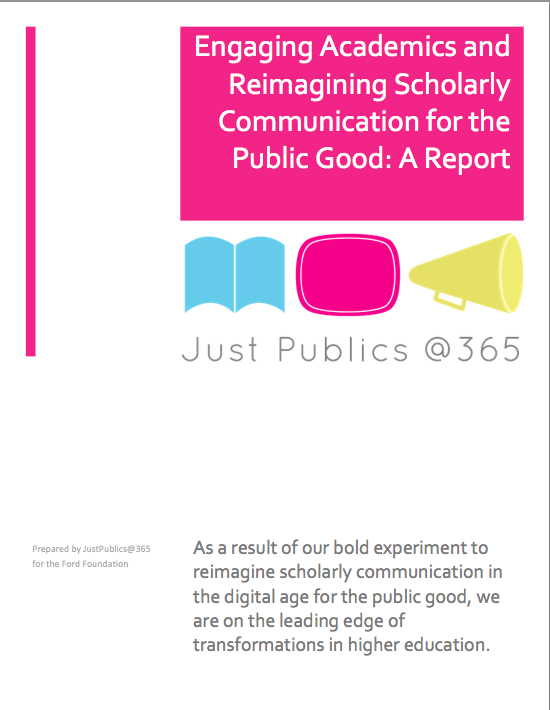It’s the beginning of a new semester as well as the new year. There are new faces in my classroom, and taxes are due. And, with JustPublics@365, the figure of the public intellectual is very much on my mind.
A couple years ago at a weekly Friday departmental talk, I was surprised when a very respected professor bemoaned the dearth of contemporary public intellectuals. We have no Voltaires, he said, and as a culture we are suspicious of too much erudition. Another professor joined him to urge us, graduate students in this public university, to publish outside academia because really, hardly anyone is reading your 30-page article in the leading academic journal in your field. “You have to get yourself out there, and heard by a wider audience,” they exhorted.
Listening to them, I wondered: I teach between 50 to 90 students per semester; isn’t that “public” enough? Each week, my inbox floods with notices of talks, exhibitions, readings, screenings, and panel discussions that I look through and delete—there’s just not enough time for everything. It seemed, in the small circles I moved in, that there were too many public intellectuals. If only these academics stayed home a bit more and did a teeny bit less, I might have the leisure to make it to more of their events.
It’s been a few semesters since this gripey reflection, and I now realize how different my experience is from, say, that of my students. Consider the results of a brief, informal survey: Only a handful of hopeful engineers in my community college classroom had heard of Stephen Hawking, whose author photo from A Brief History of Time (1988) was one of the most significant images of my childhood. My film studies class had a few young people who lived and breathed film, though a majority would have trouble locating the Angelika. But the biggest challenge by far is with my English literature students, who study literary theory and British modernism with me. Few public intellectuals are spouting insights based on structural linguistics or psychoanalytic criticism, and even fewer reference nuggets from James Joyce, Virginia Woolf, T. S. Eliot, and the like. To my students, the value of the material we cover is purely personal because, they see, there’s no place for that kind of language or discourse in the so-called real world. If there are “text-to-world” connections (such a favourite in pedagogic short-hand) between the classroom and the rest of lived experience, well, those connections are largely restricted to out-of-the-box ideas about romance and relationships, not job decisions and work ethics. In a kind of mental extension of the Levittown mentality, the personal is separated from public life, matters of head and heart firmly distanced, and although my students acknowledge that the literary modernists had pretty good things to say about interpersonal relationships, I’m also told in no uncertain terms that the “modernist mood” is no help at all with practicalities. We measure out our lives with coffee spoons, but what good does it do to point it out?
 Mark Halsey, “A Short History of Modernist Painting” (1982)
Mark Halsey, “A Short History of Modernist Painting” (1982)
All of which would have upset the modernists at least a little. Although modernism is most famous for being difficult, snooty, cold-hearted, and abstruse (to pick only the nicer adjectives my students supply), modernist writers were eager to be part of larger dialogues and the bigger picture. They felt the need to “Make it new”—not only for themselves, but for the culture as a whole. George Orwell, one of my dearest literary figures, was so committed to political action that he volunteered for the Spanish Civil War and was shot in the throat for his pains; he also managed to get a lovely book out of it. Eliot, for all his erudition, was intimately concerned with steering the intellectual climate of interwar England. The stultification they experienced, the alienation, loss, emasculation—all this was meant to draw in the unwary reader and then pull the rug out from under them, so to speak, and make it impossible to read any run-of-the-mill mush in quite the same way again.
In Nightwood, Djuna Barnes writes about failed relationships (among other things) and why we fall so stupidly in love with the wrong people over and over again. But really, she’s talking about education and the incipient danger of gender stereotypes:
“We were impaled in our childhood upon [unsuitable, stereotypical lovers] as they rode through our primers, the sweetest lie of all, now come to be in boy or girl, for in the girl it is the prince, and in the boy it is the girl that makes a prince a prince—and not a man. They go far back in our lost distance where what we never had stands waiting; it was inevitable that we should come upon them, for our miscalculated longing has created them. They are our answer to what our grandmothers were told love was, and what it never came to be; they, the living lie of our century” (145-6).
This passage is startling in its use of semi-colons, but further, it manages to succinctly connect fairy tales and children’s books to complex questions about gender (“princes” and “princesses”), identity (“a prince—and not a man”), illusions (“miscalculated longing”), and family structures (we inherit the dreams of our grandmothers, which seem so much more benign than those of our mothers). I like to spend a good bit of time in class discussing how our training molds and shapes us, and annoy students by suggesting that all this education is really designed to leave them (us) quiescent. I say, borrowing Barnes’ irony, that you “take away a man’s conformity and you take away his remedy,” leaving him like “the paralyzed man in Coney Island who had to lie on his back in a box” (155) as gawpers passed by. As we read, we find that these insights are from a middle-aged cross-dressing drunk, the false Dr. Matthew O’Connor. Social commentary with a dash of raucous melodrama: who wouldn’t want to read this book cover-to-cover?
All of which is to say, the modernists are no longer in the public eye, and maybe they are as over-intellectual as my students claim, but that doesn’t preclude their relevance today. One of the missions of JustPublics@365 is to invite participatory voices from beyond the academy; I propose we extend this “beyond” to those chilly, austere, literary modernist works that urge us to think outside and behind, to probe and question, to declaim the system even as it teaches you to speak. BLAST.


 Mark Halsey, “A Short History of Modernist Painting” (1982)
Mark Halsey, “A Short History of Modernist Painting” (1982)

